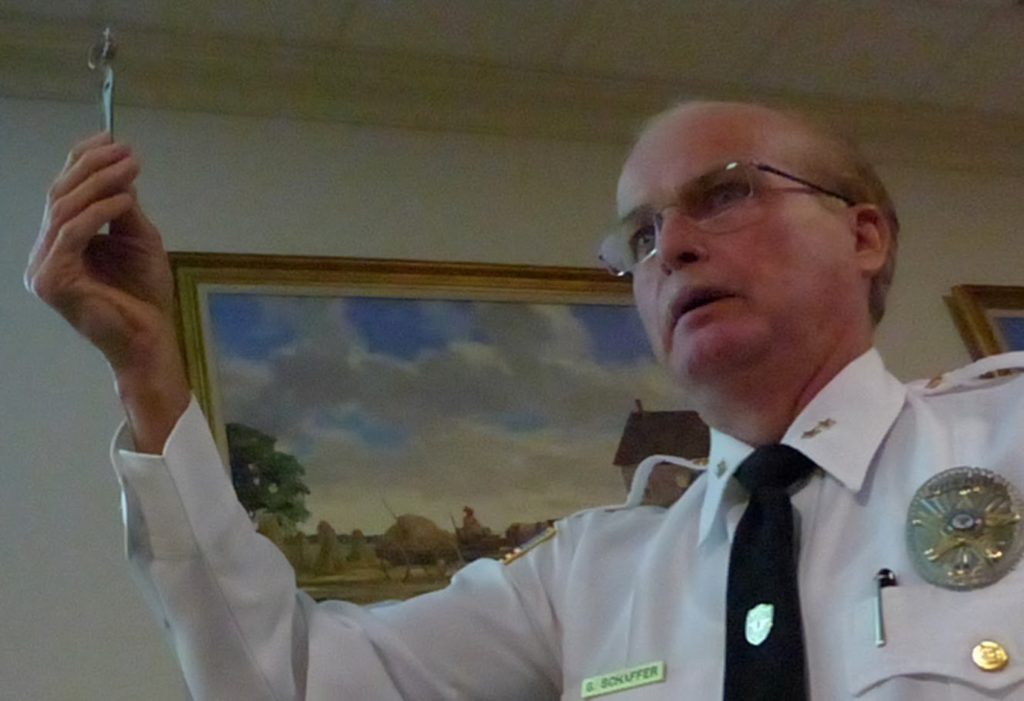CREST HAVEN – When the Cape May County Correctional Center was built in 1976, Ann Marie McMahon, director of Facilities and Services, was 2 years old. At that tender age, McMahon had no way of knowing the facility would one day become a major part of her workload.
“I was 2 years old when this jail was built, so I was not responsible for the construction,” she laughingly told freeholders Oct. 11.
During that meeting, a detailed review was made by Sheriff Gary Schaffer, Warden Donald Lombardo and McMahon as to what led the county to begin construction Aug. 2 of the $37-million, 85,000-square-foot facility.
That correctional center will feature modular cells and provide state-mandated space for inmates. Fancy it is not.
The present correctional center is crumbling in many areas and rusting in others. When the new jail is complete the present structure, which was constructed of hollow concrete blocks, will be demolished.
McMahon began work with the county in 2006, and “always heard about the jail.” Her department oversees jail maintenance and has a staff member permanently assigned there. On average, the county spends $500,000 on a variety of “unforeseen issues” maintaining the jail. That figure is expected to be “significantly less” once inmates reside in the new facility.
As an example of the jail’s condition, McMahon told of a call received from Lombardo, who reported “an inmate locked in.” “I said weren’t they supposed to be locked in? He said ‘No, we can’t get him out.’” The hardware in a control area had failed.
That raised eyebrows of Freeholder E. Marie Hayes, a retired county detective, who questioned the safety of corrections officers who might similarly be locked in an area with no way to escape, due to antiquated hardware.
To repair failing parts, McMahon said her department had often resorted to securing items from auto parts stores. That, coupled with her staff’s ability to “piece things together” has enabled the jail to continue operation.
Built to house 169, the jail was renovated once to allow an inmate population of 188. On average the inmate population is 230-250. That means cramped living spaces, sometimes placing three inmates in a double cell, meaning one must sleep on the floor.
The jail’s double cells are 30-35 square feet while the state requires a minimum of 70 square feet.
The holding cell is presently 49 square feet while the state requirement is 60 square feet.
One illustration shown was of a heavily rusted window frame that had been caulked. When such metallic surfaces corrode, inmates may pick off jagged pieces and fashion them into “shanks” which can cause serious injury or death to other inmates or corrections officers.
Schaffer held up several such inmate-fashioned weapons to underscore what is happening at the jail.
McMahon said if an inmate floods the cell, with an overflowing toilet, there is no way to shut the cell off. Before anything can be fixed, officers must go into the cell and remove the inmates. Then repairs can be made.
When accusations are made to McMahon about “building the new Taj Mahal,” she said she is prepared to defend it. “Because I pay the bills. I know what is happening at the present facility,” she said.
McMahon began working with an architect in 2008 to review what options could be available.
In 2013, that architect’s response was an estimate of $29.5 million to renovate the facility, but not fix its major discrepancies. That estimate did not include repair of the warden’s area or the housing units.
In the present dayroom, space is approved for 11 inmates, yet 20 inmates populate that area.
McMahon cited other state Department of Corrections regulations that could mean the county could be ordered to transfer 95 inmates (at the cost of $90 per inmate per day) to another facility, due to the overcrowding.
The medical facility in the present jail does not allow for private consultations, as demanded by federal regulations for health matters. Because of its smallness, medical costs and hospital visits by inmates have escalated. The replacement medical facility will have an ample medical facility, McMahon said.
The county faced four options:
* Close the jail. Pay $22,500 a day ($90 each for 250 inmates) or $8.2 million annually to some county. That price excludes medical hospital costs, when other costs were tallied, a closed jail would still cost $12 million annually.
* Renovate the present facility. $29.5 million and still inadequate.
* Regionalize. Join with five counties. Problems included transportation issues. Oversight of correction officers?
* Erect a new jail. Modular cells, medical facility. Tighter security. Outside recreation areas not visible to mourners at the County Veterans Cemetery as at present.
As an aside, Schaffer said the laundry in the new jail would provide service to Crest Haven Nursing and Rehabilitation Center at a savings to the county of $110,000 annually.








